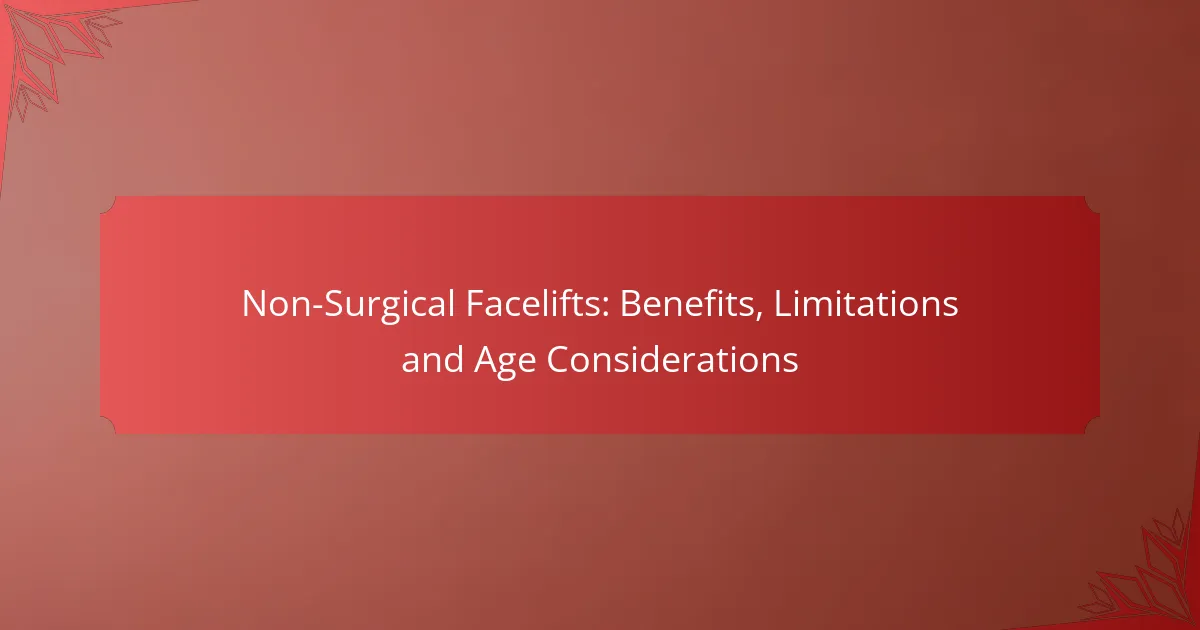Non-surgical facelifts present a popular alternative for those seeking facial rejuvenation without the invasiveness of traditional surgery. Offering benefits such as quicker recovery times and natural-looking results, these procedures are particularly effective for individuals aged 30 to 50, who are often experiencing the early signs of aging. With a focus on enhancing skin elasticity and minimizing fine lines, non-surgical options provide a tailored approach to aesthetic enhancement.

What are the benefits of non-surgical facelifts in South Africa?
Non-surgical facelifts in South Africa offer numerous advantages, including minimal invasiveness, quicker recovery times, and cost-effectiveness compared to traditional surgical options. These procedures can provide natural-looking results tailored to individual needs, making them an appealing choice for many seeking facial rejuvenation.
Minimally invasive procedures
Non-surgical facelifts typically involve techniques such as dermal fillers, Botox, and thread lifts, which require little to no incisions. This minimally invasive nature reduces the risk of complications and allows for a more comfortable experience during treatment.
Patients can often return to their daily activities shortly after the procedure, making it a convenient option for those with busy lifestyles.
Reduced recovery time
One of the significant benefits of non-surgical facelifts is the reduced recovery time compared to surgical facelifts. While surgical options may require weeks for full recovery, non-surgical treatments often allow patients to resume normal activities within a few days.
This quick recovery is particularly advantageous for individuals who want to avoid extended downtime or disruptions to their schedules.
Cost-effective compared to surgical options
Non-surgical facelifts are generally more affordable than their surgical counterparts. In South Africa, the cost of non-surgical procedures can range from a few thousand rand to tens of thousands, depending on the treatment type and extent.
Patients can achieve noticeable results without the financial burden associated with surgical facelifts, making these options accessible to a broader audience.
Natural-looking results
Non-surgical facelifts are designed to enhance facial features subtly, resulting in natural-looking outcomes. Techniques like fillers and Botox can smooth wrinkles and restore volume without altering one’s appearance dramatically.
This approach appeals to individuals who desire rejuvenation without the telltale signs of surgery.
Customizable treatment plans
Each non-surgical facelift can be tailored to meet the specific needs and goals of the patient. Practitioners assess individual facial structures and concerns to create a personalized treatment plan that addresses unique issues.
This customization ensures that patients receive the most effective combination of treatments, maximizing results while minimizing risks.

What are the limitations of non-surgical facelifts?
Non-surgical facelifts offer several benefits, but they also come with notable limitations that potential patients should consider. These include temporary results, less dramatic changes compared to surgical options, possible side effects, and the need for multiple treatment sessions to achieve optimal outcomes.
Temporary results
Non-surgical facelifts typically provide results that last from several months to a couple of years, depending on the technique used. For instance, dermal fillers may last six months to a year, while radiofrequency treatments can offer effects for up to two years. Patients should be prepared for the need to schedule follow-up treatments to maintain their appearance.
Less dramatic changes than surgical facelifts
While non-surgical facelifts can enhance facial contours and reduce signs of aging, they generally produce subtler results than traditional surgical facelifts. Surgical options can remove excess skin and provide significant tightening, while non-surgical methods focus on volume restoration and skin texture improvement. This means that individuals seeking major transformations may find non-surgical options insufficient.
Potential side effects
Non-surgical facelifts can lead to side effects, although they are usually mild and temporary. Common reactions include swelling, bruising, and redness at the injection sites. In rare cases, more serious complications like allergic reactions or infections may occur. It’s essential for patients to discuss potential risks with their provider before undergoing treatment.
Requires multiple sessions for optimal results
Achieving the best outcomes with non-surgical facelifts often requires multiple sessions. For example, initial treatments may need to be followed by maintenance sessions every few months to sustain results. Patients should plan their schedules and budgets accordingly, as these repeated visits can add up in terms of both time and cost.

What age group benefits most from non-surgical facelifts?
Individuals aged 30 to 50 typically benefit the most from non-surgical facelifts. This age range often experiences the initial signs of aging, making them ideal candidates for treatments that enhance skin elasticity and reduce fine lines without the need for invasive procedures.
Ideal for individuals aged 30-50
Non-surgical facelifts are particularly effective for those in their 30s to 50s, as this group usually begins to notice subtle changes in skin texture and firmness. Treatments like dermal fillers and Botox can restore volume and smooth out wrinkles, providing a refreshed appearance.
At this age, skin is still relatively resilient, allowing for better results with non-invasive techniques. Many individuals in this demographic seek to maintain their youthful look without undergoing surgery, making these options appealing.
Effective for early signs of aging
Non-surgical facelifts are designed to target early signs of aging, such as fine lines, sagging skin, and loss of volume. Procedures like laser therapy and ultrasound treatments can stimulate collagen production, helping to rejuvenate the skin.
These treatments are often quick, with minimal downtime, allowing individuals to return to their daily routines shortly after. For those noticing early signs of aging, these options can serve as a proactive approach to maintaining a youthful appearance.
Considerations for older adults
While non-surgical facelifts can be beneficial for older adults, results may vary based on skin condition and elasticity. Individuals over 50 may experience more pronounced sagging and may require combination treatments to achieve desired outcomes.
It’s essential for older adults to consult with a qualified professional to discuss realistic expectations and potential limitations. Tailored treatment plans can help address specific concerns, ensuring that the approach aligns with their unique skin needs.

How do I choose the right non-surgical facelift procedure?
Choosing the right non-surgical facelift procedure involves assessing your individual needs, understanding available techniques, and consulting with a qualified practitioner. This ensures that you select a method that aligns with your skin type and aesthetic goals.
Consultation with a qualified practitioner
Start by scheduling a consultation with a licensed and experienced practitioner who specializes in non-surgical facelifts. During this meeting, discuss your goals, medical history, and any concerns you may have. A qualified professional can provide personalized recommendations based on your unique situation.
Ask about their credentials, experience, and before-and-after photos of previous clients. This will help you gauge their expertise and the potential results you can expect.
Understanding different techniques
Familiarize yourself with various non-surgical facelift techniques, such as dermal fillers, Botox, and thread lifts. Each method has its own benefits and limitations; for instance, fillers can add volume but may require touch-ups every few months, while thread lifts offer longer-lasting results but may involve more downtime.
Research the pros and cons of each technique to determine which aligns best with your desired outcome. Consider factors such as recovery time, cost, and the extent of results you wish to achieve.
Evaluating personal skin type and concerns
Your skin type and specific concerns play a crucial role in selecting the right non-surgical facelift procedure. For example, individuals with thinner skin may benefit more from fillers, while those with sagging skin might find thread lifts more effective.
Take note of your skin’s elasticity, texture, and any existing conditions, such as acne or rosacea. Discuss these factors with your practitioner to ensure the chosen procedure addresses your needs effectively and safely.

What are the costs associated with non-surgical facelifts in South Africa?
The costs of non-surgical facelifts in South Africa can vary widely based on the type of treatment and the provider. Generally, patients can expect to pay anywhere from a few thousand to tens of thousands of rand, depending on the complexity and materials used.
Average price range for treatments
The average price for non-surgical facelift treatments in South Africa typically ranges from 5,000 ZAR to 30,000 ZAR. Popular procedures like dermal fillers and Botox injections usually fall on the lower end of this spectrum, while more advanced options, such as thread lifts, may reach the higher end.
For example, a single session of Botox might cost around 2,000 ZAR, while a comprehensive treatment plan involving multiple sessions and various techniques could total 25,000 ZAR or more.
Factors influencing cost
Additionally, the type of treatment chosen plays a crucial role. For instance, longer-lasting fillers or advanced techniques like ultrasound therapy may incur higher costs compared to basic procedures. Always inquire about the specific products and techniques being used, as these can significantly impact both the price and results.
